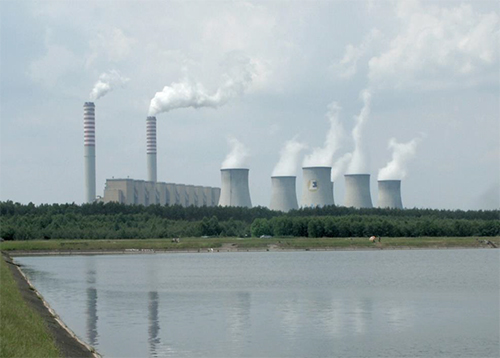FOSSIL-FUELED POWER PLANTS
A fossil fuel power plant is a power station which burns a fossil fuel such as coal, natural gas, or petroleum to produce electricity. Central station fossil fuel power plants are designed on a large scale for continuous operation. In many countries, such plants provide most of the electrical energy used. Fossil fuel power stations have machinery to convert the heat energy of combustion into mechanical energy, which then operates an electrical generator. The prime mover may be a steam turbine, a gas turbine or, in small plants, a reciprocating internal combustion engine. All plants use the energy extracted from expanding gas, either steam or combustion gases. Very few MHD generators have been built which directly convert the energy of hot, moving water into electricity. MHD means Magneto hydrodynamics, which is the study of the magnetic properties of electrically conducting fluids. Examples of such magneto fluids include plasmas, liquid metals, salt water and electrolytes. By-products of thermal power plant operation must be considered in their design and operation. Waste heat energy, which remains due to the finite efficiency of the Carnot, Rankine, or Diesel power cycle, is released directly to the atmosphere or river/lake water, or indirectly to the atmosphere using a cooling tower with river or lake water used as a cooling medium. The flue gas from combustion of the fossil fuels is discharged to the air. This gas contains carbon dioxide and water vapor, as well as other substances such as nitrogen oxides (NOx), sulfur oxides (SO2), mercury, traces of other metals, and, for coal-fired plants, fly ash. Solid waste ash from coal-fired boilers must also be removed. Some coal ash can be recycled for building materials. Fossil fueled power stations are major emitters of carbon dioxide (CO2), a greenhouse gas which according to a consensus opinion of scientific organizations is a contributor to global warming. The results of a recent study show that the net income available to shareholders of large companies could see a significant reduction from the greenhouse gas emissions liability related to only natural disasters in the U.S. from a single coal-fired power plant. However, as of 2015, no such cases have awarded damages in the U.S. Per unit of electric energy, brown coal emits nearly two times as much CO2 as natural gas, and black coal emits somewhat less than brown. Post combustion carbon capture and storage of emissions is not currently available for all fossil fuel power stations.


